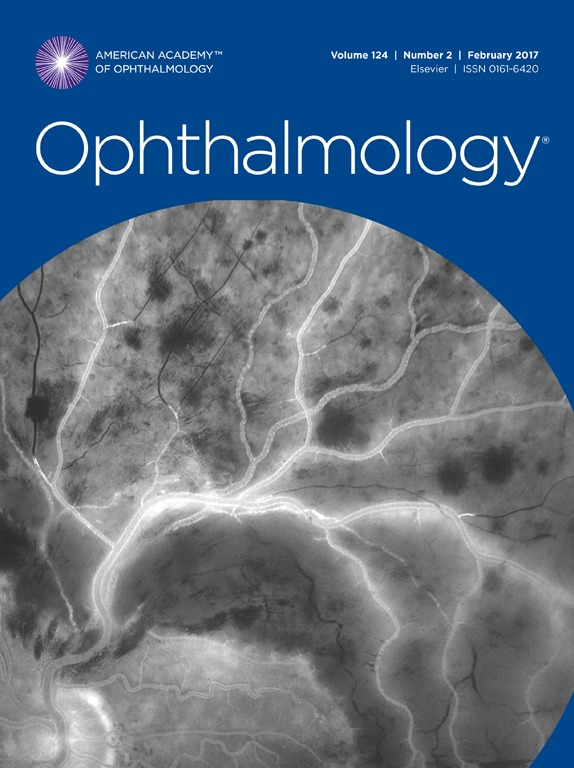Evidence-Based Guidelines for Keratorefractive Lenticule Extraction Surgery
IF 13.1
1区 医学
Q1 OPHTHALMOLOGY
引用次数: 0
Abstract
Topic
Development of evidence-based guidelines for keratorefractive lenticule extraction (KLEx).
Clinical Relevance
Keratorefractive lenticule extraction refers to various corneal refractive procedures involving removal of refractive lenticules of intrastromal corneal tissue, typically through a small incision, eliminating creation of a corneal flap. This technique has gained popularity rapidly; however, no clinical practice guidelines exist.
Methods
These evidence-based guidelines were developed following the World Health Organization guidebook using the Appraisal of Guidelines for Research and Evaluation II tool and adhering to the Reporting Items for Practice Guideline in Healthcare statement. The body of evidence was drawn from 8 literature databases, 5 clinical guideline databases, and 2 academic organizations. Recommendations were developed via a Delphi consensus of 44 global experts in refractive surgery, cornea, retina, glaucoma, and optometry. The certainty of evidence, balance of benefits and harms, patient preferences and values, and economic evaluations were considered fully. The Grading of Recommendations Assessment, Development, and Evaluation approach was used to assess evidence quality and recommendation strengths.
Results
From 385 initial clinical questions, 15 were identified, prompting a review of 250 717 studies, with 609 included for conducting and updating 26 and 2 systematic reviews, respectively. Subsequently, consensus was reached on 38 recommendations for preoperative screening, candidate selection, intraoperative quality control, operating principles, postoperative monitoring, and complication management. For KLEx, an effective and accurate refractive correction is attributed to various factors such as corneal thickness, degree of myopia, treatment nomogram, and optical zone. For complications that could affect vision, comprehensive and effective management strategies were proposed, particularly for wrong-plane dissection and difficult lenticule removal, suction loss, and perioperative infection. Customized surgical planning protocols and operative techniques were analyzed. Among all recommendations, 29 (76%) were labelled as strong, each externally reviewed. The corneal biomechanical properties may help to improve safety and predictability, although they need further validation. Several research gaps for enhancing KLEx safety were also revealed.
Conclusions
These guidelines provide evidence-based recommendations for KLEx in clinical practice, such as for preoperative screening for keratoconus, surgical planning, and management and prevention of complications and infection. The guidelines are expected to minimize the complications and achieve better outcomes.
Financial Disclosure(s)
Proprietary or commercial disclosure may be found in the Footnotes and Disclosures at the end of this article.
基于证据的角膜屈光性皮瓣提取手术指南。
主题:制定以证据为基础的角膜屈光透镜摘除术(KLEx)指南:为角膜屈光性皮孔摘除术(KLEx)制定循证指南:角膜屈光小体摘除术(KLEx)是指通过小切口摘除角膜基质内屈光小体,从而避免制作角膜瓣的各种角膜屈光手术。这种技术作为角膜瓣手术的一种可能的替代方法迅速受到欢迎;然而,目前还没有关于 KLEx 的临床实践指南:这些循证指南是根据世界卫生组织指南、AGREE II 工具和 RIGHT 声明制定的。证据来自八个文献数据库、五个临床指南数据库和两个学术组织。建议是由全球屈光手术、角膜疾病、视网膜疾病、青光眼和验光配镜领域的 44 位专家通过德尔菲法达成共识后制定的。充分考虑了证据的确定性、益处和危害的平衡、患者的偏好和价值观以及经济评估。采用 GRADE 方法评估证据质量和推荐强度:从最初的 385 个临床问题中,确定了 15 个问题,从而对 250,717 项研究进行了审查,其中 609 项研究被纳入其中,分别进行了 26 项和 2 项系统审查,并对其进行了更新。随后,就术前筛查、候选者选择、术中质量控制、操作原则、术后监测和并发症处理等方面的 38 项建议达成了共识。对于 KLEx 而言,有效和准确的屈光矫正取决于多种因素,如角膜厚度、近视程度、治疗提名图和光学区。针对可能影响视力的 KLEx 相关并发症,提出了全面有效的处理策略,尤其是针对错面剥离和难以去除的扁桃体、吸引损失和围手术期感染。对定制的手术计划方案和手术技术进行了分析。在所有建议中,有 29 项(76%)被评为 "强",每项建议都经过了外部审查。对角膜生物力学特性的评估可能有助于提高安全性和可预测性,但仍需进一步验证。制定过程中还发现了一些提高角膜塑形镜安全性的研究空白:这些指南为临床实践中的角膜屈光手术提供了循证建议,如术前角膜病筛查、手术计划、并发症和感染的管理和预防。该指南有望提高 KLEx 手术的安全性和有效性,并获得更满意的视觉矫正效果。
本文章由计算机程序翻译,如有差异,请以英文原文为准。
求助全文
约1分钟内获得全文
求助全文
来源期刊

Ophthalmology
医学-眼科学
CiteScore
22.30
自引率
3.60%
发文量
412
审稿时长
18 days
期刊介绍:
The journal Ophthalmology, from the American Academy of Ophthalmology, contributes to society by publishing research in clinical and basic science related to vision.It upholds excellence through unbiased peer-review, fostering innovation, promoting discovery, and encouraging lifelong learning.
 求助内容:
求助内容: 应助结果提醒方式:
应助结果提醒方式:


